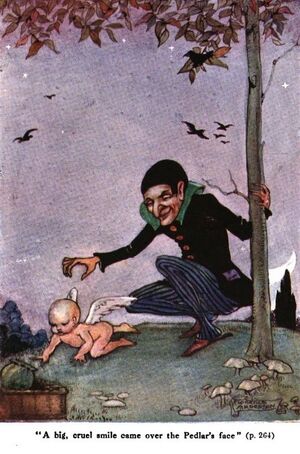
Illustration from Little Folks, 1915
Florence Mary Anderson (1889-1945) ' the children's illustrator and writer was born at Greenock, Scotland on 23 June 1889, the fourth child of John, a wealthy sugar merchant and his second wife Mary Matilda (née Matthews)
In 1908, at the age of 19, Florence Anderson applied to attend afternoon classes in drawing and painting at the Glasgow School of Art. The formal art training she acquired in Glasgow provided Florence with a foundation on which she could develop her interpretative skills as an author and illustrator. Having completed her studies at Glasgow, she won a scholarship for a year’s course in drawing and painting at Bradford College of Art and then, in 1912, another scholarship to the Slade School of Fine Art under the tutelage of Henry Tonks (1862-1937).
Her studies completed, she joined a coterie of artists and writers, each with their own subject speciality, who regularly contributed to Little Folks and other titles in Cassell’s range of periodical publications. She also began working for Simpkin Marshall, Hamilton, Kent & Co, initially on a cover and 16 signed full-colour plates for The Dream Pedlar by Lady Margaret Sackville.
This early success brought her work to the attention of other publishers and further opportunities to illustrate children’s books came her way throughout the War period. After the War, illustration commissions continued, including: The Rainbow Twins, which she wrote and illustrated, published by Joseph Johnson in 1919 (then an imprint of Simpkin Marshall); and The Password to Fairyland (1920) by Elizabeth Southwart. These were her most productive years.
It is no coincidence that all the books illustrated by Anderson were written by women. Contemporary women children’s authors and their publishers favoured her unthreatening and delicate touch.
In May 1914 a liaison with fellow Slade School student, Thomas Mackenzie, had resulted in the birth of her son, Murray Anderson Mackenzie. Although they had lived apart for several years, Mackenzie and Anderson were concerned about the legitimacy of their son and so they married in July 1925 at Hampstead Registry Office. Shortly afterwards Anderson filed for divorce on the grounds of Mackenzie’s alleged adultery. It is on record that the parties were suspected of collusion, but subsequent enquiries failed to substantiate this view. A divorce was granted in October 1928.
From 1923 Anderson lived by the River Thames at Strand-on-the Green, Chiswick, where she belonged to the Chiswick Group of Artists and earned a living from her landscape paintings, portraits, teaching and designing and selling greetings cards. Sadly, by the mid-1920s her career as a book illustrator was all but over, although she tried to generate more interest in her work. She visited the Swiss Alps on several occasions and exhibited her work in London galleries including the Beaux Arts Gallery in 1928. Until almost the end of her career, Anderson was exclusively an illustrator of folk lore and fairy tales.
She died on 21 July 1945.
Art historians and writers have frequently confused or conflated this artist with the illustrator and stage designer, Florence Mary "Molly" MacArthur (1893-1972), whose married name was Anderson, and whose illustrations are roughly contemporary with Anderson's. However, MacArthur always seems to have used her maiden name professionally.
Bibliography
Burkhauser, Jude (Ed): ‘Glasgow Girls’ Women in Art & Design 1880-1920, Canongate, 1990.
Hone, Joseph: The Life of Henry Tonks, Heinemann, 1939.
Thomas, Alison: Portraits of Women: Gwen John and Her Forgotten Contemporaries, Polity Press, 1994.
Wall, Francis: Exhibition of Pictures (catalogue), Menston Music and Arts Society, 1946
White, Colin: Thomas Mackenzie and the Beardsley Legacy, Journal of Decorative & Propaganda Arts, Winter1988.